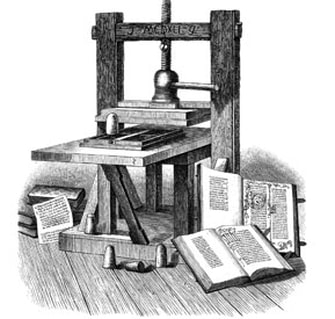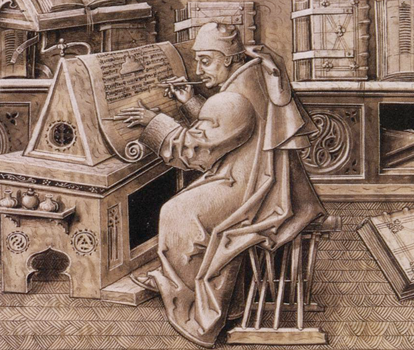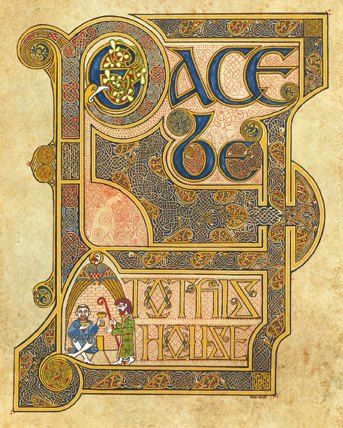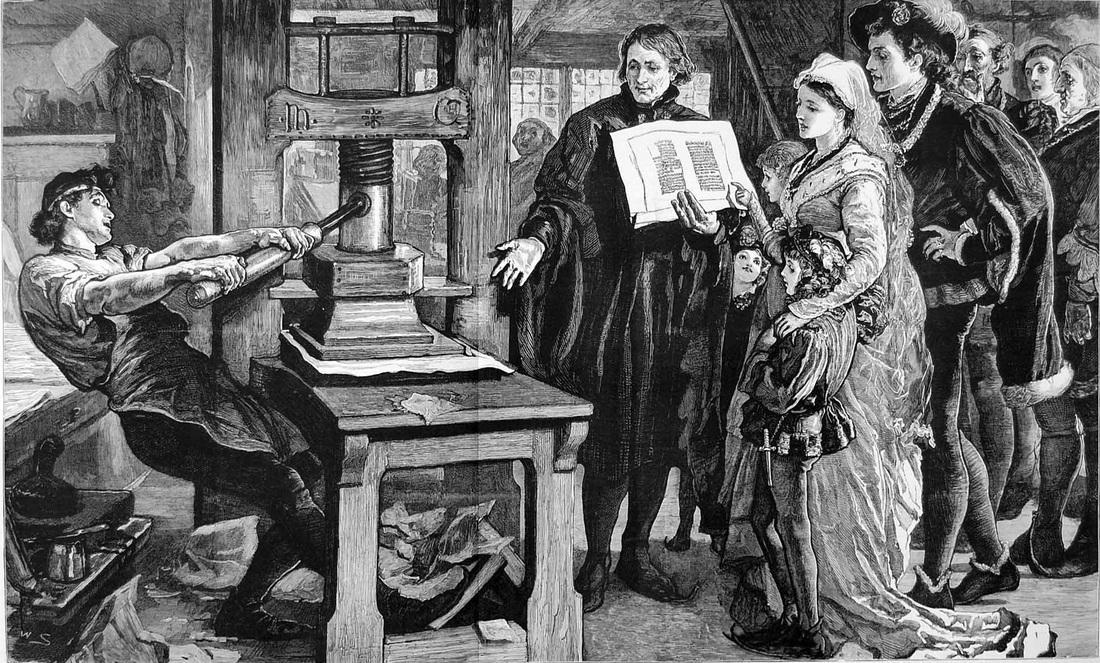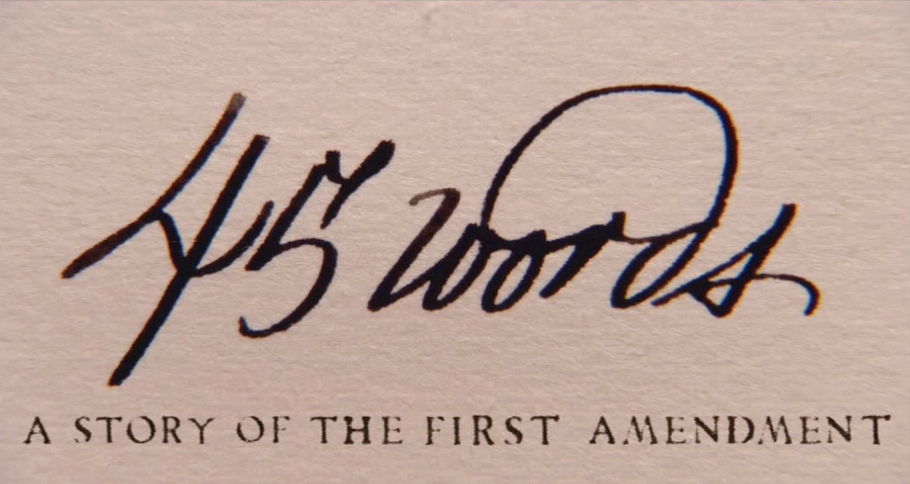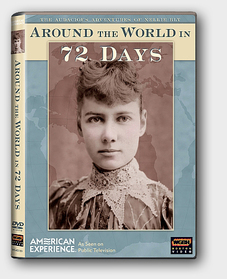Blue text indicates a link.
It's best not to rely on a printed version of this page. Assignments are subject to change at any time. Check this page frequently for updates.
It's best not to rely on a printed version of this page. Assignments are subject to change at any time. Check this page frequently for updates.
Week 1: 1/6-9MONDAY: Introductions: Get to know the syllabus. Lecture/discussion: What is media history and why study it?
WEDNESDAY: From writing to printing, and the press in early America. Read:
|
(Above right) Before the invention of the printing press, all books were hand-written and bound. An illuminated manuscript is a book written and decorated completely by hand. They were among the most precious objects produced in the Middle Ages and the early Renaissance, primarily in monasteries and courts. Video: J. Paul Getty Museum
http://www.getty.edu/art/exhibitions/making/
http://www.getty.edu/art/exhibitions/making/
(Above left) The story of Johannes Gutenberg, how his printing press was invented, and why. Part of the series "Great Moments in Science and Technology."
Week 2: 1/13-15MONDAY: Reporting the Revolutionary War
Read:
Online: Watch the video (right) on the birth of the First Amendment |
Click on the image to view the story of the First Amendment and the years following its passage. From the Newseum's Digital Classroom.
|
|
WEDNESDAY: Journalism in the 19th century: Jacksonian Democracy and the emergence of the Penny Press.
Read:
Watch: The video (right) on the early history of advertising. |
A short clip from Sell & Spin: A History of Advertising. It takes us from the earliest advertising to the birth of the ad agency in the 19th century.
|
Week 3: 1/20-22MONDAY: Martin Luther King Jr. holiday. NO CLASS TODAY
WEDNESDAY: The Victorian Internet: The story of the Telegraph Read:
Watch: The video (above right) on Samuel Morse, the inventor of the electric telegraph. From the series, Great Moments in Science and Technology. |
|
Week 4: 1/27-29MONDAY: Activity Essay 1 is due today at 8:00 a.m. (see the direction sheet for details of the assignment.) Go to the Canvas site and submit your completed essay there. Submit your assignment on Canvas in MICROSOFT WORD FORMAT. If you use a different program, check with the instructor first. DO NOT SUBMIT IT AS A PDF FILE!
ALSO MONDAY: We will watch The Great Transatlantic Cable in class. See more information on the right. |
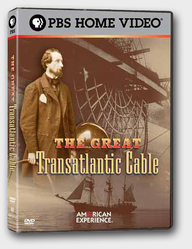
This program tells the story behind the laying of the transatlantic cable. The physical challenges to laying the cable were enormous. The project would require the production of a 2,000 mile long cable that would have to be laid three miles beneath the Atlantic. Cyrus Field, an energetic young New Yorker wasn't deterred, and since its completion in 1866, nothing has broken his communications link with Europe—not storms, earthquakes or war.
|
WEDNESDAY: Photography and the rise of illustrated news in the Civil War
Read:
Read:
- Newspapers in the Civil War — An essay on the importance of newspapers before and during this five-year conflict.
- Artists as Journalists in the Civil War — Newspapers relied heavily on artwork to help tell the story. Meet some of the major contributors in this article.
- The First Photograph — Learn about the process of the earliest form of photography from this terrific site at the University of Texas.
- The Daguerreian Era and Early American Photography — The effects of the photographic revolution in America.
- Photography and the Civil War -- Photographs couldn't be printed in newspapers, but that didn't stop photographers from making the Civil War the first, fully photographed large-scale conflict.
Watch: The video below on the one of the most important advances in photography in the 19th century, courtesy of the George Eastman House http://www.eastmanhouse.org
|
|
The first commercially successful photographic process was announced in 1839, the result of over a decade of experimentation by Louis Daguerre and Nicéphore Niépce. Unfortunately, Niépce died before the daguerreotype process was realized, and is best known for his invention of the heliograph, the process by which the “first photograph” was made in 1826. Daguerreotypes are sharply defined, highly reflective, one-of-a-kind photographs on silver-coated copper plates, usually packaged behind glass and kept in protective cases. The daguerreotype process is demonstrated in this video. |
Week 5: 2/3-4
MONDAY: The newspaper wars and the rise of yellow journalism
Read:
- Yes, Virginia, There is a Santa Claus — One of the most-remembered articles ever written, and how it came about.
- The History of the Magazine — From its earliest European forms to modern day.
- The Muckrakers — A brief look at the journalists who exposed wrong-doing in both government and big business.
- The history of Yellow Journalism — Before the Muckrakers, there were the "stunt" journalists and the purveyors of "make-it-yourself" journalism.
- Selling the Kid — The origin of the term "yellow journalism" wasn't even a real person.
WEDNESDAY: We will watch Around the World in 72 Days, the story of Nellie Bly, one of the most fascinating characters in American journalism.
Watch: The Google Doodle below celebrating Nellie Bly |
|
Week 6: 2/10-12WEDNESDAY: WWI, Propaganda and Public Relations
Read this piece on propaganda use in WWI: And this follow-up on the rise of propaganda and public relations in the early 20th century:
Watch: The videos on the right about the typewriter and the telephone. |
|
Week 7: 2/17-19MONDAY: Pictures move: the beginnings of movie making and the reaction of censorship.
Read:
Watch: The video (right) on the Lumiere brothers of France and their development of the art and science of cinematography. WEDNESDAY: “This Magic Called Radio.”
Read:
Watch: The video on the right about the invention of the phonograph. |
From the series, Great Moments in Science and Technology.
|
Also Watch: The movies (below left) on Marconi's invention of wireless telegraphy—the earliest form of radio—and (right) on the early days of radio.
|
From the series, Great Moments in Science and Technology.
|
The Beginnings of Commercial Radio: an excerpt from Empire of the Air—the men who made radio, a PBS documentary on the invention and rise radio. Visit the companion web site at http://www.pbs.org/kenburns/empire/
|
Week 8: 2/24-26Activity Essay 2 is due MONDAY at 8:00 a.m. (see the direction sheet for details of the assignment.) Submit your assignment on Canvas in MICROSOFT WORD FORMAT. If you use a different program, check with the instructor first. DO NOT SUBMIT IT AS A PDF FILE!
MONDAY: The press in WWII Read:
Watch: The video (above right) of Bob Hope's wartime Command Performance show. |
Command Performance (1942-49) was an early hit over AFRS during World War Two. Servicemen were encouraged to write to the show and request their favorite stars, and suggest performances they would like to hear. This version, shot on film, was also recorded on disk for audio distribution abroad. For fun, see if you can decipher Betty Hutton's language used in the song "Murder he says."
|
WEDNESDAY: The rise of Television and TV advertising.
Read:
Read:
Watch: The story of TV from RCA's point of view (below left), and a brief piece on Philo T. Farnsworth (below right) , who basically invented television. (Story of Television— http://www.youtube.com/user/AntiProtonBoy. Original video source, Prelinger Archives--http://www.archive.org/details/StoryofT1956.)
|
|
|
Week 9: 3/2-3
MONDAY: Alternative and Minority media
Read: The Black Press: Soldiers Without Swords
Read: The Black Press: Soldiers Without Swords
WEDNESDAY: Journalism and change in the 60s and 70s
Read:Watch: (Below Left) An animated video on Watergate Scandal by Ari Hoptman. (Below Right) The story of the Pentagon Papers.
|
Ari Hoptman is a Minnesota-based actor and author, specializing in Germanic etymology, as well as a Marx Brothers historian.
|
On June 13, 1971, The New York Times began publishing stories based on the Pentagon Papers, a classified document about the controversial Vietnam War that had been leaked to the Times by Daniel Ellsberg, a military analyst. From the Newseum: http://www.youtube.com/user/Newseum
|
Week 10: 3/9-11
MONDAY: Another history—close to home
Watch: Reinventing Ed's Coed, below
|
|
Reinventing Ed's Coed is the story of the first student film ever made, and the current movement in Hollywood to turn it into a modern comedy. The original film stands as a testament to the history of the University of Oregon and the student initiative that created it, and this film attempts to show that that initiative is still alive.
This short documentary was produced in 2009. We'll watch part the original film in class. |
WEDNESDAY: EXAM 2: STUDY GUIDE
